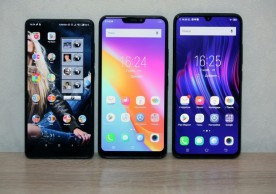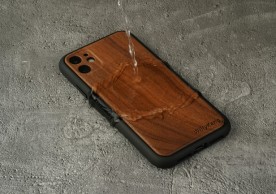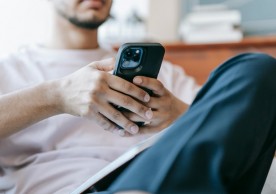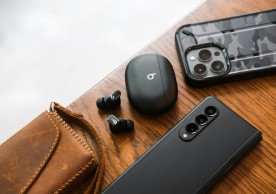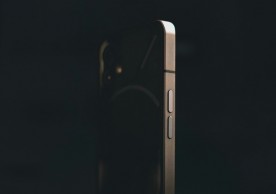With smartphones packing in cameras with higher megapixels count, the going has not been easy for the point-and-shoot cameras. What's more, with instant sharing on social networking sites being the order of the day, the point-and-shoot cameras have been losing out to smartphones.
However, with the launch of its Galaxy Camera, Samsung is attempting to infuse life into the slowly waning point-and-shoot camera space. The Samsung Galaxy Camera blends both mobile technology and photography in a single device, giving users the best of both worlds.
The internals of the Galaxy Camera resembles Samsung's best-selling Galaxy S3 smartphone on many counts, and here's a look at the device's first impressions.
Under The Hood
The Galaxy Camera features a 4.8-inch HD Super Clear LCD touchscreen with 1280 x 720 pixels resolution. The camera also boasts of a 21x optical zoom lens (equivalent to 23-483mm on a conventional 35mm camera), and a super-bright 16.3-megapixel backside illuminated CMOS sensor that has been engineered to draw less power.
The Galaxy Camera weighs 300gms and measures 70.8 x 128.7 x 19.1mm, which does not make it too big by compact camera standards.
The camera is powered by a quad-core 1.4 GHz processor. It packs in 1GB of RAM and 3.87GB of on-board storage, with the option to expand the memory to an additional 64GB via a microSD card. A 1650mAh battery fuels the camera.
The device runs on Android 4.1 Jelly Bean OS and can power apps and movie playback to the camera's 4.8-inch touchscreen display, which functions smoothly. The Galaxy Camera also offers support for both Wi-Fi and 3G if users add a microSIM and are willing to pay extra costs for the same on the network. This feature enables seamless sharing on the go, which is a first from a dedicated camera.
"Leave your laptop at home and save the luggage space. The Galaxy Camera is the only truly connected camera in the world. Straight from the camera, you can connect, upload, share, and even post to your favourite social media," notes Samsung.
Features and Modes
The Galaxy Camera has three settings: Auto, Smart, and Expert. The Auto mode offers a variety of filters and it is the camera taking control of the functionalities.
The camera's Smart Mode enables amateurs with Rich Tone HDR mode, Light Trace for 'light painting' photos. Moreover, a user also has features like Best Face and Best Photo at their disposal, which lets one pick the best shot available.
The Expert Mode lets a user manually set the shutter speed, aperture, and ISO. A common worry is that the Expert Mode may feel a little restrictive, but it doesn't and is as seamless as the other functionalities.
There's also a Voice Control mode that, as the name suggests, enables users to control the camera with their voice. Users can zoom in or out and even take a photograph with the voice command. This mode comes in handy when taking self-portraits.
Pros
Users who are familiar with Android tablets or phones will find the navigation extremely easy. The Android 4.1 Jelly Bean OS on the Galaxy Camera is fast thanks to the high-end specs and can also be upgraded. Users can easily organize widgets and apps on the home screen with no difficulty.
The Galaxy Camera not only has excellent Android integration, great UI, and is easy to use, but it also lives up to expectations and comes out tops when it comes to the device's primary purpose - that of taking good pictures. The images are of high quality, sharp and the colors are crisp. The quality of the images, however, would not trounce a DSLR, but meets expectations from a point-and-shoot camera.
The zoom on the camera is pretty good with the maximum aperture stretching to f/2.8 at the widest range. At full telephoto the aperture is f/5.9 and the tightest position is f/8 in either instance.
Sharing directly via the camera is pretty simple and is made easier with the microSIM card which will let users tweet, Facebook, or even Instagram images when they are not even in a Wi-Fi hotspot. Moreover, users can edit images directly on the camera as well.
Cons
The Galaxy Camera takes a long time to boot before the first shot can be taken. The time to switch on the camera to first shot can take anywhere between 18 to 20 seconds, which means that users may lose a few precious moments before the Galaxy Camera spurs into action.
Additionally, the Galaxy Camera stays in the standby mode by default. When a user taps the power button, the camera goes into the sleep mode instead of switching off completely. This aspect reduces time to the first shot to a few seconds; however, being in the standby mode means that the battery charge will get drained faster. Also, some users may found the device a little heavy.
The Galaxy Camera's battery is also a major drawback. The camera runs the same battery as the Galaxy S2 smartphone (1650mAh). However, unlike the smartphone, where users get upto nine hours of talk time on 3G, the Galaxy Camera's battery does not last very long owing to the internals. The battery lasts for less than half a day and needs to be recharged for a whole day of shooting.
Buy It?
The Galaxy Camera is currently one of the best case Android-powered cameras available in the market. It is an ideal camera for those who are looking for a device that allows them to share high-resolution images on the go. The Galaxy Camera is available in black or white. However, with a price tag of $499.99 (on AT&T), the camera is not exactly inexpensive.
most read
more stories from Gadgets
-
Top 6 Underrated Smartphones You Should Consider
Discover the hidden gems! Explore our list of the top 6 underrated smartphones you should consider now.
ernest hamilton -
Top 6 Water-Resistant Phones of 2024: Perfect for Any Adventure
Explore the top 6 water-resistant phones of 2024, designed to withstand any adventure. Stay connected, rain or shine!
ernest hamilton -
Top Smartphones 2024: Best Choices for Music and Movie Enthusiasts
Discover the top smartphones of 2024 tailored for music and movie enthusiasts. Elevate your entertainment experience today!
ernest hamilton -
Top 5 Android Phones for Students in 2024: A Comprehensive Guide
Discover the top 5 Android phones tailored for students in 2024! Don't miss out on this comprehensive guide to find the perfect device for your academic journey.
ernest hamilton -
Samsung Galaxy S20 FE 5G vs. iPhone 13: Choosing the Best Phone for Teens
Deciding between Samsung Galaxy S20 FE 5G and iPhone 13? Find the best phone for teens with this detailed comparison.
ernest hamilton -
8 Parent-Approved Phones for Kids and Teens
Discover 8 Parent-Approved Phones for Kids and Teens! Make the right choice for your child's first smartphone. Read our guide now!
ernest hamilton -
Samsung Galaxy S24 Plus vs. iPhone 15 Plus: Clash of the Flagship Titans
Galaxy S24 Plus vs. iPhone 15 Plus: Clash of flagship titans! Explore the battle between Samsung's latest Galaxy and Apple's upcoming iPhone. Discover which reigns supreme!
ernest hamilton -
Nothing Phone 2a vs Asus Zenfone 10: Midrange Android Battle
Midrange Android showdown: Nothing Phone 2a vs Asus Zenfone 10. Discover which device reigns supreme in our in-depth comparison. Read now for the ultimate smartphone decision!
ernest hamilton





